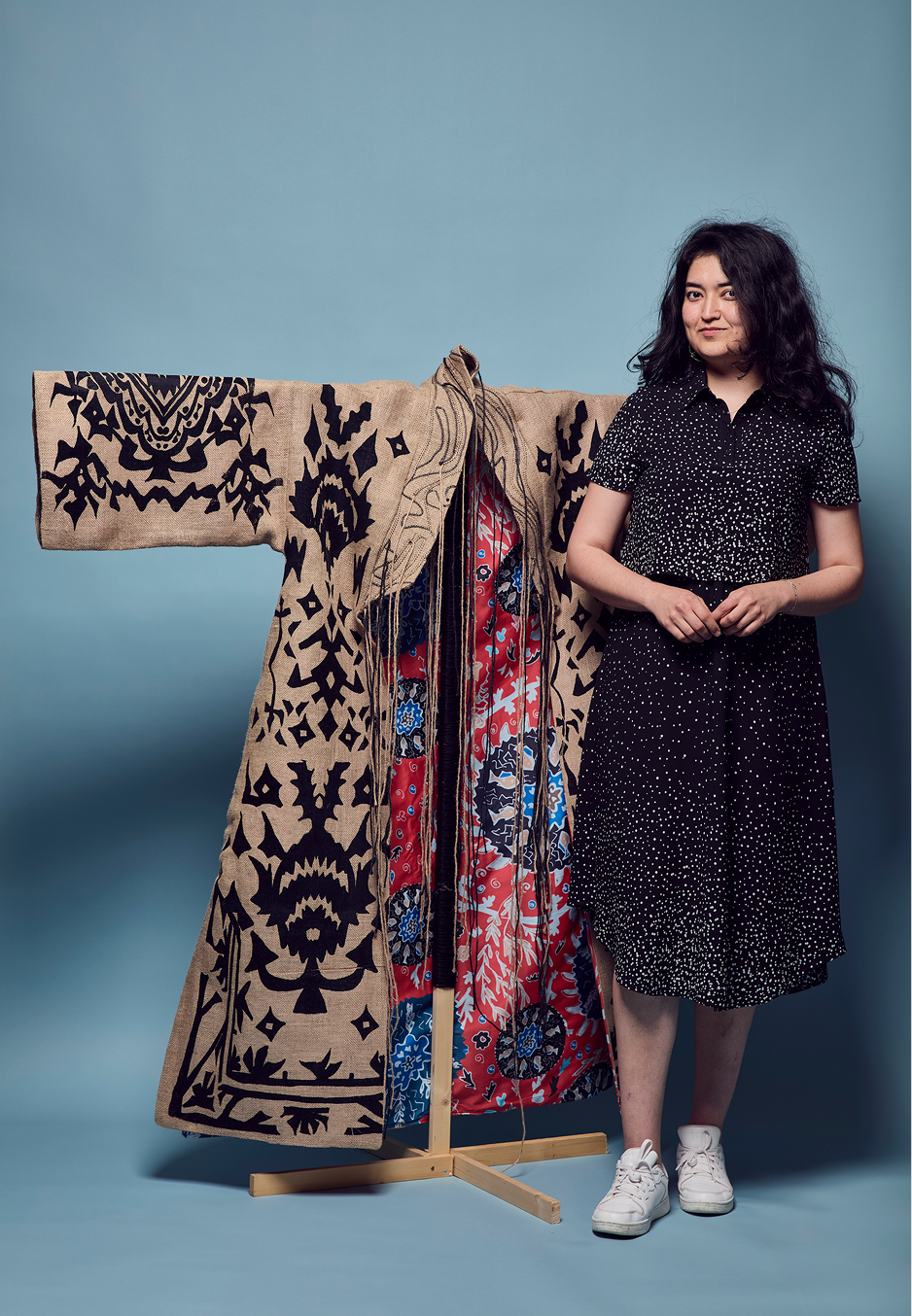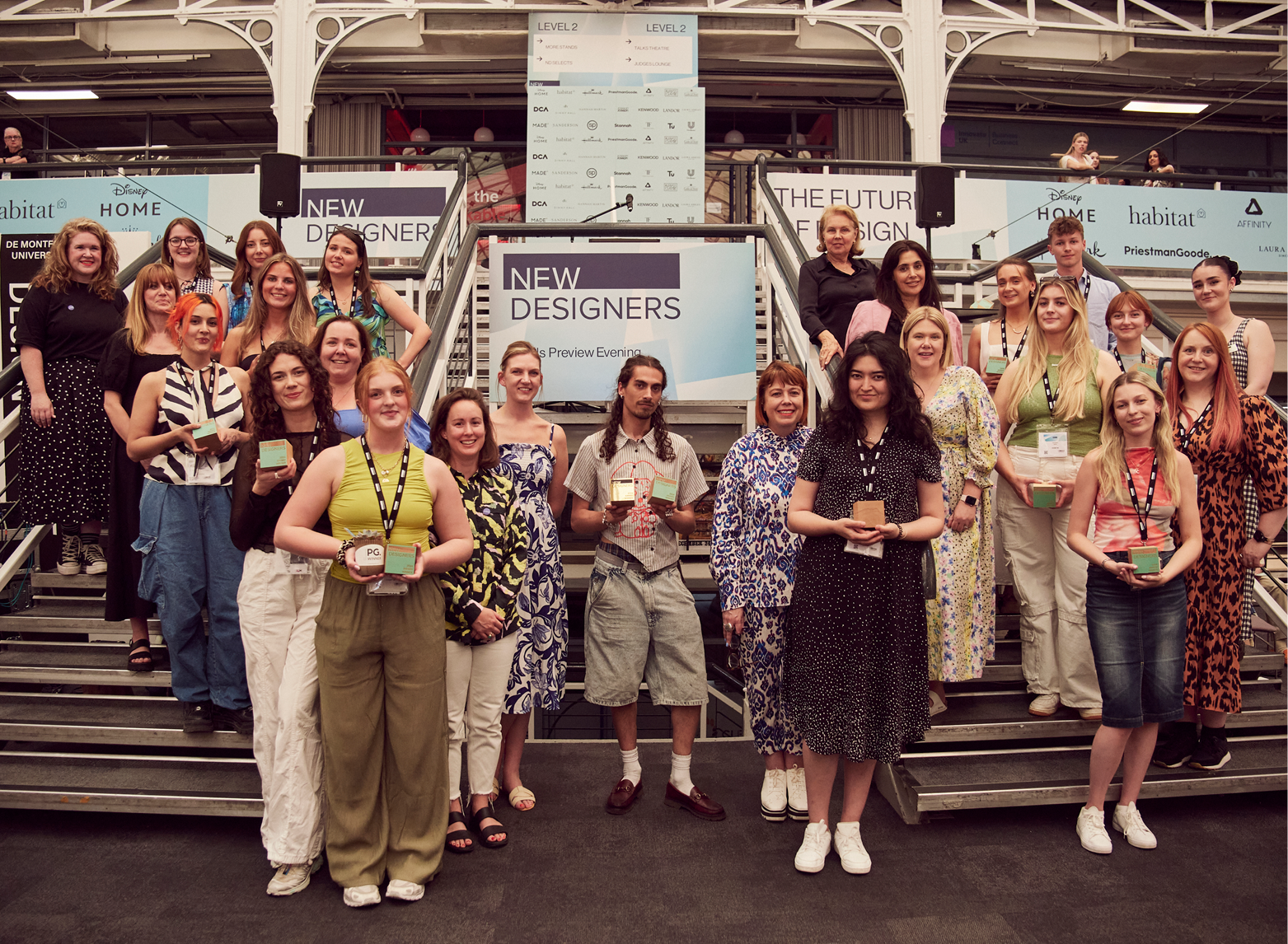New Designers reveals new talent

Zumrad Khamidova on Winning the Sanderson Award and championing sustainability at New Designers 2024
Following her Sanderson Award win at New Designers 2024, we caught up with Zumrad Khamidova to learn a little more about her work, what inspires her designs, her commitment to sustainable practices and her excitement ahead of interning at Sanderson.
New Designers was abuzz with creativity. The Sanderson team, including CEO Lisa Montague, stepped onto the show floor to explore and learn more from the talent on display. There, graduates of all art forms proudly presented their work. There was certainly no shortage of innovation, but one designer stood out from the crowd.
Zumrad Khamidova, an eco-couture designer from Uzbekistan, has printed, embroidered and threaded her design heart on her sleeve. Literally. With a collection of chapans and trousers that demonstrated a keen eye for technique and skill with a steadfast commitment to linking strong narratives through her work (always tethered to sustainable approaches), Zumrad is a more-than-worthy winner of the Sanderson Award, and we are excited to welcome her into the studio as she begins her internship.
We caught up with Zumrad to discuss her textile design work, approach to sustainability, and delving into Sanderson's historical archive of treasures in more detail.
How did you become interested in textile design?
I have always been creative and had a passion for drawing since childhood. Even though I graduated with a degree in philology (from the University of Oriental Studies in Tashkent), I always knew that a career in the arts would bring me joy.
My interest in textile design came during my foundation course, where I tried photography, printmaking, and fine art. My final work was a selection of wallpapers inspired by rare exotic plants. I created handmade 3D plants from aluminium wire and wet-strength tissue paper, then exposed every flower in a dark room to make the wallpaper. After finishing the course, I realised that I enjoyed creating prints, so I enrolled in a fashion and printed textiles course at University Centre Colchester, where I learned more about different techniques and processes, from creating prints on fabric to designing and constructing the whole garment.
What inspired your Eco Couture collection, and how have traditional Uzbek prints influenced your designs?
I was born and raised in Tashkent, surrounded by colourful atlases, Adras, Ikat, and Suzani embroidery, so I was inspired by Uzbekistan's traditional garments and historical prints.
Every motif in traditional textiles has meaning, so I wanted to include a narrative in my prints and link it to the Aral Sea issue, implementing a fish design with plants that used to grow in the Aral Sea area. I wanted to create a contemporary design while also addressing pressing environmental concerns.
I created chapans and trousers: Traditional chapans have prints outside with contrasting bright linings. So, I made sure to develop chapans with contrasting prints. I looked at chapans dating back to the 18th-19th century. Almost all of them had pieces like patchwork - they were mended with different pieces of fabric, which looked really interesting. I created patches with different prints in my collection as part of my placement print.
I was also inspired by Suzani embroidery. I learned the technique of chain stitching, embroidered a tamarisk tree, turned it into a print, and created a scarf with these faux stitching prints, retaining the embroidery look.
How do you approach sustainability in your work, and why is it important to you?
Growing up, I was always aware of unsustainable practices due to the Aral Sea issue, where a whole sea in Uzbekistan and Kazakhstan disappeared due to cotton irrigation. During the course at UCC, I learned more about the devastating effects of unsustainable practices and how the textile industry has become a significant contributor to global greenhouse gas emissions and waste generation. I learned about circular fashion, such as design for low waste, low impact materials and processes, longevity, and recyclability. I wanted to make sure that my collection had all four strategies.
I implemented a zero-waste technique in the pattern cutting of my chapans and trousers, leaving almost no offcuts. For low-impact materials and processes, I created my collection through predominantly digitally printed methods as a more environmentally friendly process than screen printing (which requires lots of water and chemicals). I used natural materials such as jute, linen and organic cotton. I learned that organic cotton has a less negative impact than conventional cotton as it uses less pesticides and less water. Both jute and linen are easy to grow, require less water and pesticides, decompose quickly, absorb carbon dioxide and release oxygen. They are all natural materials which can be easily recyclable and biodegradable.

What aspects of Sanderson as a brand are you most excited to experience during your internship?
I am excited to explore the archive and examine the historical designs in detail. It will be exciting to see how they work together as patterns and collections and how I can respond to them in a contemporary way.
posted on 05 Sep 2024 in Interiors






